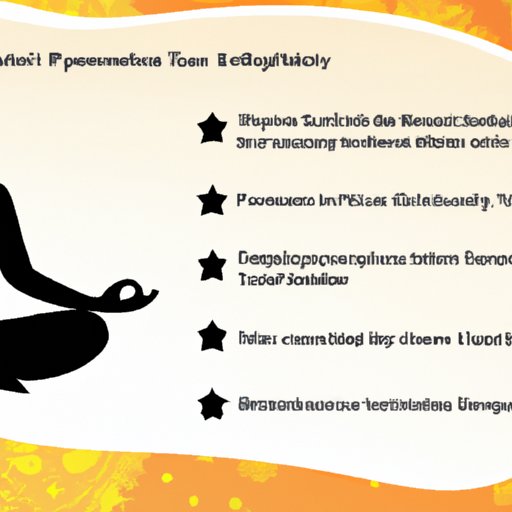Introduction
Raja yoga is an ancient practice with roots going back thousands of years. It is one of the six major paths of yoga, and focuses on the cultivation of mental and spiritual strength in order to achieve a higher level of consciousness. The purpose of this article is to explore what raja yoga is, how to practice it, and what benefits it can offer.
Overview of Raja Yoga
Raja yoga, or the “royal path”, is the practice of controlling the mind and achieving union with the divine. It is based on the teachings of the Indian sage Patanjali, who wrote the Yoga Sutras, a text outlining eight limbs of yoga as a framework for spiritual practice. The eight limbs are yama (moral observances), niyama (self-discipline), asana (posture), pranayama (breath control), pratyahara (withdrawal of the senses), dharana (concentration), dhyana (meditation), and samadhi (enlightenment).
Benefits of Raja Yoga
Raja yoga has many physical, mental, and spiritual benefits that can improve overall wellbeing. Physically, practicing postures, breath control, and meditation can help to strengthen and balance the body, reduce stress, improve flexibility, and increase energy levels. Mentally and emotionally, regular practice can lead to increased focus, clarity of thought, and improved mood. On a spiritual level, raja yoga can lead to a deeper understanding of oneself and a sense of connection to something greater than oneself.
Beginner’s Guide to Raja Yoga
If you are new to raja yoga, there are some tips for getting started. It is important to find a class or teacher that resonates with you, as having an experienced guide can be invaluable in learning the basics. When beginning your practice, start slowly and be mindful of your body’s limitations. There are some common poses that are used in raja yoga, such as downward dog, cobra, tree pose, and warrior pose. Each pose has its own benefits, so it is important to understand what each pose is meant to do and which ones are best suited to your individual needs.
Incorporating Raja Yoga Into Daily Life
Once you have established a basic practice, it is important to make time for regular practice. This can be done by setting aside a certain amount of time each day for practice, or by incorporating yoga into other activities such as walking or running. It is also important to build a routine that works for you, and to be flexible if your schedule changes.

Holistic Approach to Wellness Through Raja Yoga
Raja yoga is not just about physical postures, but about creating a holistic approach to wellness. This means connecting with your inner self and finding balance between all aspects of life, including physical, mental, and spiritual. To maintain balance, it is important to take time for yourself, cultivate gratitude, and be mindful of your thoughts and actions.
Unpacking the Principles of Patanjali’s Raja Yoga
The eight limbs of Patanjali’s Raja yoga provide a framework for spiritual growth. Each limb has a specific purpose, from cultivating moral observances to deepening concentration and meditation, and they should be practiced in sequence in order to reach the highest level, samadhi. Understanding the yogic path and its principles can help to bring clarity and focus to one’s practice, as well as a greater understanding of the self.
Conclusion
Raja yoga is an ancient practice that offers a path to greater well-being through physical, mental, and spiritual practices. By understanding the eight limbs of raja yoga, learning how to incorporate it into daily life, and taking a holistic approach to wellness, practitioners can unlock its potential for greater health and happiness.


